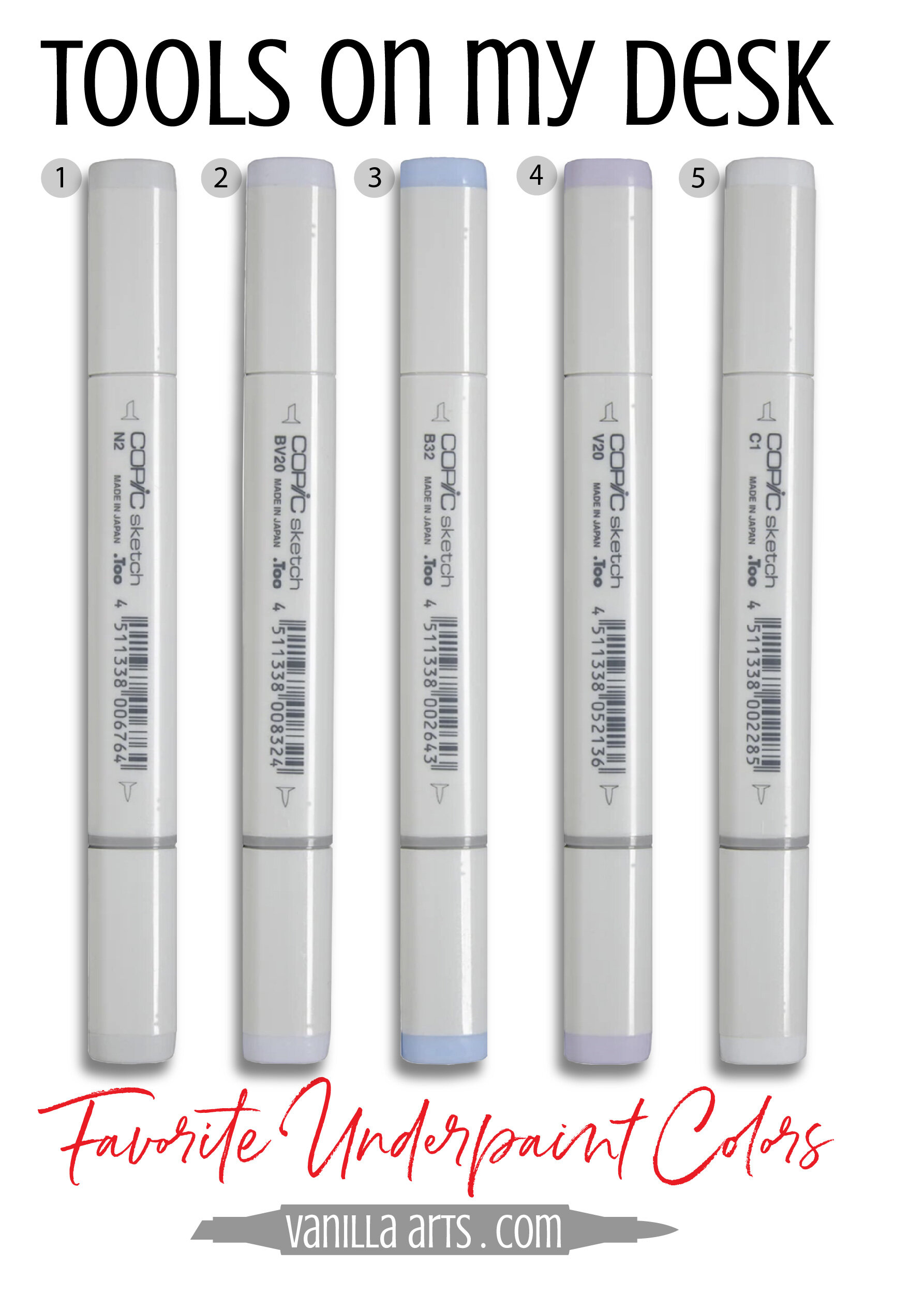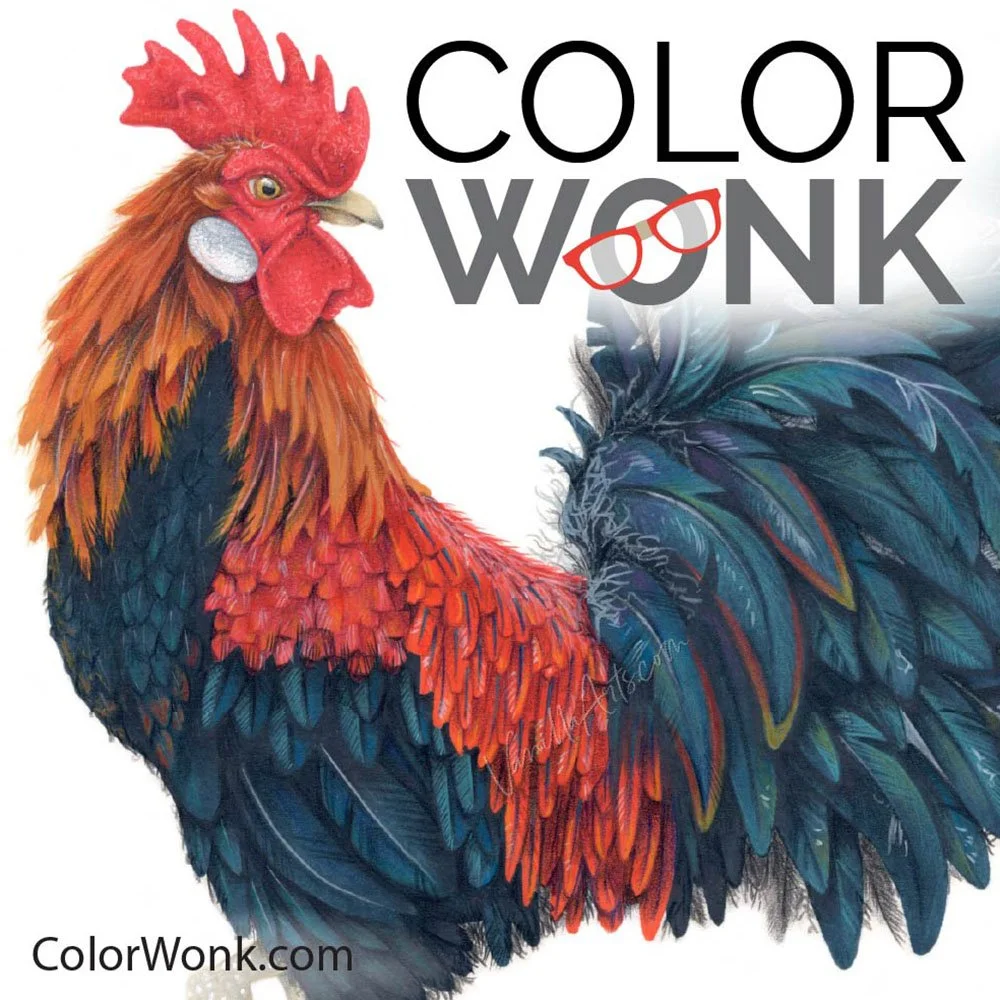Tools On My Desk: Stretch Your Copic Marker Budget by Shading with Underpaint Colors
Underpainting to save money?
But I’m a colorer. I don’t paint!
Oh but grasshopper, you do paint. You paint with markers!
If you’ve spent any amount of time here at Vanilla Arts, you know that I teach coloring classes using a painting method which I swiped from classical oil painting classes.
We don’t shade red with a dark red marker. We don’t shade blue with a darker blue marker. To develop more realistic, interesting, and complex color, we might shade red with a blue marker or green with a violet marker. This is what creates the distinctive look to my coloring.
And it has an added benefit! Students are able to build up a useful yet small collection of markers faster because they’re using the same shade markers underneath a wide variety of other colors. This eliminates having to buy that one ugly dark orange which you might only use twice a year.
Underpainting saves money!
Copic Markers are an expensive investment. The Underpainting method stretches your budget by eliminating single-use markers in favor of universal shade colors which work underneath every color. The Vanilla Team shares their favorite versatile shading markers to build a workable collection faster.
What is underpainting?
In classical oil painting, but also in watercolor and sometimes colored pencil, the underpainting technique is where you paint all the shade first. Then you add transparent color over the top.
Basically, you paint the project twice— the first time in black & white, then you add color over the top of it.
If you underpaint in gray, it’s called Grisaille (“griss-eye”) but you can also underpaint with sepia tones, with a brick red, or for real brain bending fun, you can underpaint with all the direct complements of each color.
In markers, I teach a modified technique where instead of coloring everything twice, we add the underpaint color to the blending combination. This works better for Copics but it also makes the technique easier to understand for beginners.
I can’t teach you the underpainting process in one quick article, but I do have numerous articles and classes on the subject. Here’s a bit to get you started but you’ll see underpainting is the theme running through most of my writing and ALL of my classes.
Underpainting eliminates single-use markers, allowing you to buy 2-marker blending combinations instead of trios.
By using the same gray, violet, or even blue marker to shade everything from yellow to purple, you save money by eliminating the darkest marker from every trio!
Today, let’s look at the Vanilla Team’s favorite all-purpose underpainting markers— what they use them for and why you might find it handy too.
Underpaint for Realism
The Strawberry Trio project you see here is the grand finale project of my 12-week Copic Marker course, Marker Painting Foundations.
Yes, you start the course as a beginner and leave with this fabulous set of berries PLUS the knowledge and techniques to color all your projects with this kind of realism!
Marker Painting is a completely different approach to coloring.
Well, actually it's the classic approach, learning to use your Copic Markers the way an artist uses paint.
Marker Painting breaks all the crafty coloring laws and the copy-cat approach to instruction. Art based painting technique sets you free from marker tutorials, recipes, and all the supposed rules that actually lock you into flat and simplistic coloring.
You can learn to color independently.
You can get realism and amazing depth from your Copics.
The rest of this article contains affiliate links to trusted retailers like Dick Blick and Amazon.
Vanilla Arts Company is a participant in the Amazon Services LLC Associates Program, an affiliate advertising program designed to provide a means for use to earn fees by linking to Amazon.com.
The Vanilla Team’s Favorite Copic Markers for underpainting:
Interestingly, when I asked for the team’s most-used underpainting colors, they all asked “but what are we coloring?” Some colors work well for anything but others are more specific to the subject or mood you want to capture.
Kathy was embarrassed to say that she doesn’t even think of it as underpainting anymore. Underpainting isn’t really a separate technique anymore. In her mind, it’s just what she has to do to create realistic color.
Which colors do we reach for most?
1. Tried and True Neutrals: Because Copic underpainting is based on the Grisaille technique, you can’t go wrong with a set of gray markers. The grays are so versatile that I recommend making a gray set one of your first purchases.
Choose either the Neutral Grays or the Cool Grays. The Warms have a slightly greenish cast to them which can lead to a few unexpected surprises (not the good kind). Also, I never use Toner grays and if you have the Neutrals, you’ll never need the Toners. They’re a niche color that is really only useful to print shop employees.
If you’re a serious penny pincher, only buy the evens or just the odd grays. I rarely need to use both a 1 and a 2 side-by-side in the same project.
I recommend N2, N4, N6, and N8 in my budget conscious beginner marker set here.
2 All-Purpose Underpainting: Frankie and I both rely on BV markers.
Frankie doesn’t have specific BVs that she uses all the time but in general, she’ll choose BVs before anything else.
In my personal work, I use BV20/23/25/29 so often that they sit in a mug on my desk and rarely return to her storage unit. If I were stranded on a desert island, the BV20’s would be in my emergency supply kit.
3. Bold Botanicals: Elena loves bold and vivid colors. To get an extra boost of brightness, she relies on B32 and B34 markers. They’re great under greens but also make for stunning “indescribable” color underneath floral reds, pinks, and oranges.
4. Natural & Organic: I prefer flowers that are a bit more naturalistic. To develop the olive undertones in greenery and for touchably real petals, I reach for V20/V22/V25 and V28 Copics.
5. Smart & Studious: Kathy grabs her C6/C5/C4/C3/C2/C1 markers to create a dead coloring of her image. This is a great way to really study your image before coloring and to know if you have enough contrast in your image to create the realism you want to achieve.
Want More Underpaint Colors?
As you get better at underpainting, you’ll want to expand beyond the money saver groups listed above.
Because honestly, once you get a taste for creating unique, complex, and realistic colors… well, it’s addictive!
Remember, the underpaint color does not match the top color.
The goal is to create a new color, not darken the existing color!
Another point to keep in mind is that we generally don’t underpaint to create beautiful color, we usually underpaint to create shade!
This means your new colors should not be bright, clean, or overly vibrant. If you want realistic looking shade, you want muddy, murky, and slightly indescribable colors.
Elena, our fun and amazing team member, has developed an incredibly comprehensive underpainting resource here at Vanilla Arts. She shares new underpainting combination swatches every Thursday, perfect for saving as pins on Pinterest or make a cool swatch booklet!
Want to know more about underpainting?
Join me for Rosie Gets the Blues, a lesson on complementary underpainting and for real looking depth and dimension.
Underpainting is not hard to learn and once you’ve got this skill under your belt, you’ll be able to shade any project with greater realism.
You don’t have to be an artist with a gigantic brain and overflowing talent to master this method! Underpainting is for everyone.
Rosie Gets the Blues
Join me for a fun Copic Marker + Colored Pencil lesson in the Vanilla Workshop
Rosie Gets the Blues was recorded live, now it’s available as a Marker Painting Workshop with anytime access.
Vanilla Livestream is a live demonstration program from Vanilla Arts.
Edited classes with perfect narration tend to make the coloring process look faster, easier, and smoother than it really is.
Stop comparing yourself to the supermodel version of an artist!
Real time coloring with real mistakes and real fixes.
Class Printable Pack Includes:
Class syllabus with detailed recipe guide
Full color project sample
Guide to Copic base
Detailed color map
Project inspiration references
Our Favorite Underpainting Markers:
Vanilla Arts Company is a participant in the Amazon Services LLC Associates Program, an affiliate advertising program designed to provide a means for use to earn fees by linking to Amazon.com.




















